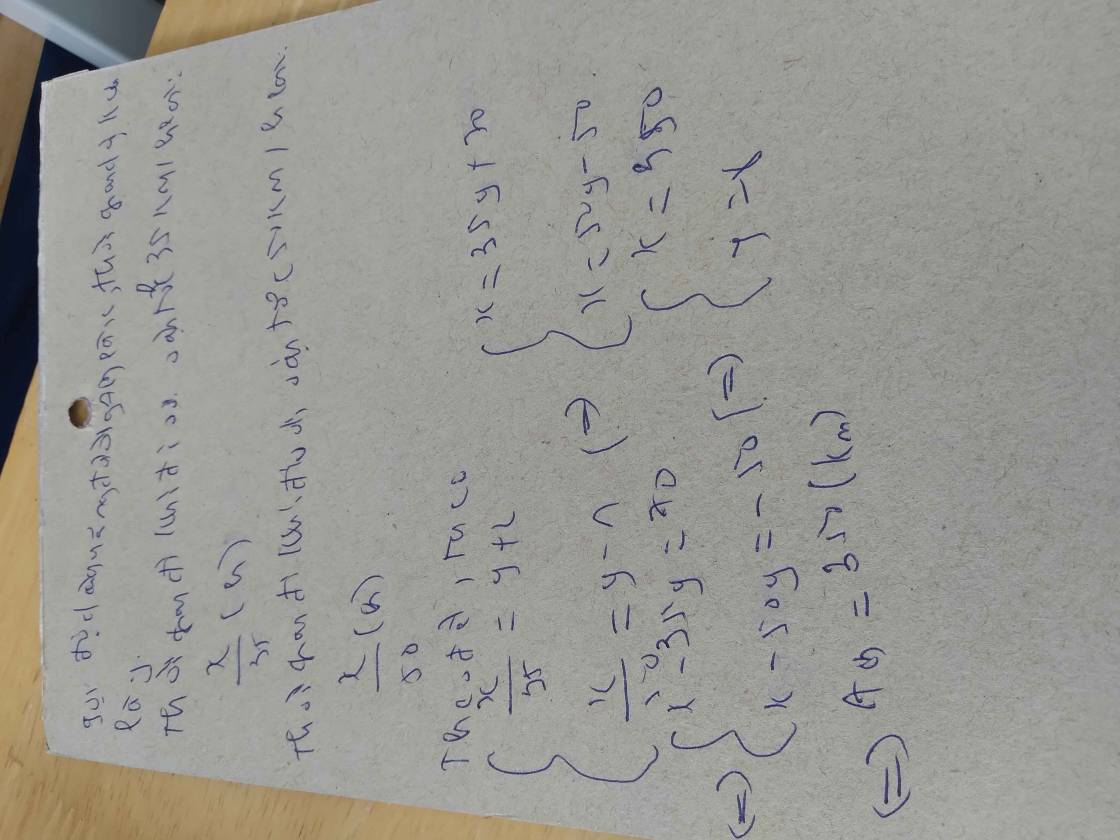
Ôn tập: Phương trình bâc nhất một ẩn
Gọi hình thoi đề bài cho là hình thoi ABCD, M,N,P,Q lần lượt là trung điểm của AB,AD,CD,BC
Xét ΔADB có
AM/AB=AN/AD=1/2
=>MN//DB và MN=1/2BD
Xét ΔCDB có CQ/CB=CP/CD=1/2
nên PQ//BD và PQ=1/2BD
=>MN//PQ và MN=PQ=8cm
Xét ΔBAC co BM/BA=BQ/BC=1/2
=>MQ//AC và MQ=1/2AC=5cm
=>MQ vuông góc BD
=>MQ vuông góc MN
Xét tứ giác MNPQ có
MN//PQ
MN=PQ
MQ vuông góc MN
=>MNPQ là hình chữ nhật
=>\(S_{MNPQ}=5\cdot8=40\left(cm^2\right)\)
Đúng 0
Bình luận (0)
9x2-1+(3x-1)(x+2=0
Lời giải:
$9x^2-1+(3x-1)(x+2)=0$
$\Leftrightarrow (3x-1)(3x+1)+(3x-1)(x+2)=0$
$\Leftrightarrow (3x-1)(3x+1+x+2)=0$
$\Leftrightarrow (3x-1)(4x+3)=0$
$\Leftrightarrow 3x-1=0$ hoặc $4x+3=0$
$\Leftrightarrow x=\frac{1}{3}$ hoặc $x=\frac{-3}{4}$
Đúng 2
Bình luận (0)
9x2 - 1 + (3x - 1)(x + 2) = 0
\(\Leftrightarrow\) 9x2 - 1 + 3x2 + 6x - x - 2 = 0
\(\Leftrightarrow\) 12x2 + 5x - 3 = 0
\(\Leftrightarrow\) 12x2 - 4x + 9 x - 3 = 0
\(\Leftrightarrow\) (12x2 - 4x) + (9x - 3) = 0
\(\Leftrightarrow\) 4x(3x - 1) + 3(3x - 1) = 0
\(\Leftrightarrow\) (3x - 1)(4x + 3) = 0
\(\Leftrightarrow\) \(\left[{}\begin{matrix}3x-1=0\\4x+3=0\end{matrix}\right.\) \(\Leftrightarrow\) \(\left[{}\begin{matrix}x=\dfrac{1}{3}\\x=\dfrac{-3}{4}\end{matrix}\right.\)
S = \(\left\{\dfrac{1}{3},\dfrac{-3}{4}\right\}\)
Đúng 0
Bình luận (0)
câu 1:giải các pt và bpt sau: a,17x - 5(x+3)= 2x + 5 b,3/x+2 - 5/x-2 = 11x + 23/(x+2)(x-2) c,5x + 7 ≥ 3(x-1) d,3x-1/x+1 = -2/5 e,(2x-1)(2x+1)= 4x2 + 3x + 2 f,x-3^3 -7+3x g,7x-5 < 2(4x-1)+7
a: =>17x-5x-15-2x-5=0
=>10x-20=0
=>x=2
b: =>\(\dfrac{3x-6-5x-10}{\left(x+2\right)\left(x-2\right)}=\dfrac{11x+23}{\left(x+2\right)\left(x-2\right)}\)
=>11x+23=-2x-16
=>13x=-39
=>x=-3(nhận)
c: =>5x+7>=3x-3
=>2x>=-10
=>x>=-5
d: =>5(3x-1)=-2(x+1)
=>15x-5=-2x-2
=>17x=3
=>x=3/17
e: =>4x^2-1-4x^2-3x-2=0
=>-3x-3=0
=>x=-1
g: =>7x-5-8x+2-7<0
=>-x-10<0
=>x+10>0
=>x>-10
Đúng 0
Bình luận (0)
\(\dfrac{x+2}{2008}+\dfrac{x+3}{2007}+\dfrac{x+5}{2005}+\dfrac{x+4}{2006}=-4\)
Tính
\(\dfrac{x+2}{2008}+\dfrac{x+3}{2007}+\dfrac{x+5}{2005}+\dfrac{x+4}{2006}=-4\\ \Rightarrow\dfrac{x+2}{2008}+\dfrac{x+3}{2007}+\dfrac{x+5}{2005}+\dfrac{x+4}{2006}+4=0\\ \Rightarrow\dfrac{x+2}{2008}+\dfrac{x+3}{2007}+\dfrac{x+5}{2005}+\dfrac{x+4}{2006}+1+1+1+1=0\\ \Rightarrow\left(\dfrac{x+2}{2008}+1\right)+\left(\dfrac{x+3}{2007}+1\right)+\left(\dfrac{x+5}{2005}+1\right)+\left(\dfrac{x+4}{2006}+1\right)=0\\ \Rightarrow\dfrac{x+2010}{2008}+\dfrac{x+2010}{2007}+\dfrac{x+2010}{2005}+\dfrac{x+2010}{2006}=0\\ \Rightarrow\left(x+2010\right)\left(\dfrac{1}{2008}+\dfrac{1}{2007}+\dfrac{1}{2005}+\dfrac{1}{2006}\right)=0\)
mà `1/2008+1/2007+1/2005+1/2006≠ 0`
`=> x+2010=0`
`=>x=-2010`
Đúng 4
Bình luận (0)
\(\Leftrightarrow\left(\dfrac{x+2}{2008}+1\right)+\left(\dfrac{x+3}{2007}+1\right)+\left(\dfrac{x+5}{2005}+1\right)+\left(\dfrac{x+4}{2006}+1\right)=0\)
=>x+2010=0
=>x=-2010
Đúng 1
Bình luận (0)
một phân xưởng sản xuất súng theo kế hoạch mỗi ngày phải sản xuất được 150 cây súng. Nhưng đang sản xuất thì bị thằng hàng xóm đánh đau quá nên phải đẩy nhanh tiến độ để có thể chiến đấu với hàng xóm nên mỗi ngày đã sản xuất thêm được 30 cây súng nữa. Do đó chẳng những hoàn thành kế hoạch sớm hơn 2 ngày mà còn vượt mức 40 cây súng nữa. Tinh số cây súng phải sản xuất theo kế hoạch?
Đọc tiếp
một phân xưởng sản xuất súng theo kế hoạch mỗi ngày phải sản xuất được 150 cây súng. Nhưng đang sản xuất thì bị thằng hàng xóm đánh đau quá nên phải đẩy nhanh tiến độ để có thể chiến đấu với hàng xóm nên mỗi ngày đã sản xuất thêm được 30 cây súng nữa. Do đó chẳng những hoàn thành kế hoạch sớm hơn 2 ngày mà còn vượt mức 40 cây súng nữa. Tinh số cây súng phải sản xuất theo kế hoạch?
Một ô tô dự định đi từ A đến B trong một thời gian nhất định. Nếu xe chạy với vận tốc 35km/h thì đến nơi chậm mất 2 giờ. Nếu xe chạy với vận tốc 50km/h thì đến nơi sớm hơn 1 giờ. Tìm quãng đường AB
X^2 = 2
`x^2=2`
\(\Leftrightarrow\left[{}\begin{matrix}x=\sqrt{2}\\x=-\sqrt{2}\end{matrix}\right.\)
Đúng 1
Bình luận (0)
BT: giải
\(\dfrac{1}{x^2-5x+6}+\dfrac{1}{x^2-7x+12}+\dfrac{1}{x^2-9x+20}+\dfrac{1}{x^2-11x+30}=\dfrac{1}{8}\)
\(\dfrac{1}{x^2-5x+6}+\dfrac{1}{x^2-7x+12}+\dfrac{1}{x^2-9x+20}+\dfrac{1}{x^2-11x+30}=\dfrac{1}{8}\)
\(\Leftrightarrow\dfrac{1}{\left(x-2\right)\left(x-3\right)}+\dfrac{1}{\left(x-3\right)\left(x-4\right)}+\dfrac{1}{\left(x-4\right)\left(x-5\right)}+\dfrac{1}{\left(x-5\right)\left(x-6\right)}=\dfrac{1}{8}\)
\(\Leftrightarrow\dfrac{1}{x-2}-\dfrac{1}{x-3}+\dfrac{1}{x-3}-\dfrac{1}{x-4}+\dfrac{1}{x-4}-\dfrac{1}{x-5}+\dfrac{1}{x-5}-\dfrac{1}{x-6}=\dfrac{1}{8}\)
\(\Leftrightarrow\dfrac{1}{x-2}-\dfrac{1}{x-6}=\dfrac{1}{8}\)
\(\Leftrightarrow\dfrac{x-6-x+2}{\left(x-2\right)\left(x-6\right)}=\dfrac{1}{8}\)
\(\Leftrightarrow\dfrac{4}{\left(x-2\right)\left(x-6\right)}=\dfrac{1}{8}\)
\(\Leftrightarrow32=\left(x-2\right)\left(x-6\right)\)
\(\Leftrightarrow32=x^2-8x+12\)
\(\Leftrightarrow x^2+8x-20=0\)
\(\Leftrightarrow\left(x+2\right)\left(x-10\right)=0\)
\(\Leftrightarrow\left[{}\begin{matrix}x=-2\\x=10\end{matrix}\right.\)
Đúng 2
Bình luận (1)
3x/2 + 11/x = 4/3 Giải phương trình sau
\(\dfrac{3x}{2}+\dfrac{11}{x}=\dfrac{4}{3}\)\(\left(dkxd:x\ne0\right)\)
\(\Leftrightarrow\dfrac{3x}{2}+\dfrac{11}{x}-\dfrac{4}{3}=0\)
\(\Leftrightarrow\dfrac{3x.3x+11.6-4.2x}{6x}=0\)
\(\Leftrightarrow9x^2+66-8x=0\)
\(\Leftrightarrow9x^2-8x+66=0\)
\(\Leftrightarrow\) Pt vô nghiệm
Đúng 1
Bình luận (0)







